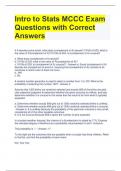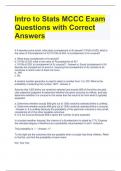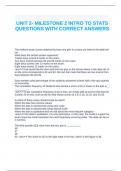Intro stats - Study guides, Class notes & Summaries
Looking for the best study guides, study notes and summaries about Intro stats? On this page you'll find 253 study documents about Intro stats.
Page 4 out of 253 results
Sort by
UNIT 2- MILESTONE 2 INTRO TO STATS QUESTIONS WITH CORRECT ANSWERS

-
Sophia Intro to Stats Unit 5 Milestone 5,
- Exam (elaborations) • 23 pages • 2023
-
- $19.49
- + learn more
RATIONALE Using the z-chart to construct a 97% CI, this means that there is 1.5% for each tail. The lower tail would be at 0.015 and the upper tail would be at (1 - 0.015) or 0.985. The value of 0.9850 is actually on the z-table exactly. 0.9850 corresponds with a z-score of 2.17. CONCEPT Confidence Intervals 2 George measured the weight of a random sample of 49 cartons of apples. The mean weight was 45.5 pounds, with a standard deviation of 3. To see if the cartons have a significant...

-
Intro to Stats MCCC Exam Questions with Correct Answers
- Exam (elaborations) • 7 pages • 2024
-
Available in package deal
-
- $8.99
- + learn more
Intro to Stats MCCC Exam Questions with Correct Answers If A denotes some event, what does (complement of A) denote? If P(A)=0.003, what is the value of P(complement of A)? If P(A)=0.003, is (complement of A) unusual? a. What does (complement of A) denote? b. If P(A)=0.003, what is the value of P(complement of A)? c. If P(A)=0.003, is (complement of A) unusual? - Answer-a. Event (complement of A) denotes the complement of event A, meaning that (complement of A) consists of all outcome...

-
Sophia Intro to Stats Unit 2 Milestone 2,
- Exam (elaborations) • 20 pages • 2023
-
- $18.99
- + learn more
In which of these cases should the median be used? When the data has small variance When data has no outliers When the data has extreme values When the data has nominal values RATIONALE Since the mean uses the actual values in the data, it is most affected by outliers and skewness. So, we only want to use the mean when the data is symmetric as a measure of centrality. When the data is skewed or has extreme values, the median is a better measure since it is not as sensitive to the...

-
Sophia Intro to Stats Unit 2 Milestone 2.
- Exam (elaborations) • 20 pages • 2023
-
- $18.99
- + learn more
In which of these cases should the median be used? When the data has small variance When data has no outliers When the data has extreme values When the data has nominal values RATIONALE Since the mean uses the actual values in the data, it is most affected by outliers and skewness. So, we only want to use the mean when the data is symmetric as a measure of centrality. When the data is skewed or has extreme values, the median is a better measure since it is not as sensitive to the...

-
Sophia Intro to Stats Unit 3 Milestone 3
- Exam (elaborations) • 16 pages • 2023
-
- $19.49
- + learn more
Which of the following is a property of binomial distributions? All of the observations made are dependent of each other. There are exactly four possible outcomes for each trial. The expected value is equal to the number of successes in the experiment. The variable of interest is the total number of successes or failures for a given number of observations. RATIONALE Recall that for the binomial distribution we are concerned with an event occurring (successes) or not occurring (fail...

-
Sophia Intro to Stats Unit 1 Milestone 1
- Exam (elaborations) • 14 pages • 2023
-
- $19.49
- + learn more
A hunter is practicing his aim using a practice target. He takes 5 shots. All 5 shots hit the target, but they do not hit or surround the bullseye. In addition, all 5 shots are very spread apart on the target. Classify the hunter's accuracy and precision. Low accuracy and low precision High accuracy and low precision Low accuracy and high precision High accuracy and high precision RATIONALE Since the arrows fall away from the bullseye and are spread out we would classify this as...

-
Sophia Intro to Stats Unit 1 Milestone 1,
- Exam (elaborations) • 14 pages • 2023
-
- $18.49
- + learn more
very spread apart on the target. Classify the hunter's accuracy and precision. Low accuracy and low precision High accuracy and low precision Low accuracy and high precision High accuracy and high precision RATIONALE Since the arrows fall away from the bullseye and are spread out we would classify this as low accuracy and low precision. CONCEPT Accuracy and Precision in Measurements 2 A team of researchers want to measure the distance covered while driving compared to a car'...

-
Intro to Stats MCCC Exam Questions with Correct Answers
- Exam (elaborations) • 7 pages • 2024
-
- $7.69
- + learn more
Intro to Stats MCCC Exam Questions with Correct Answers If A denotes some event, what does (complement of A) denote? If P(A)=0.003, what is the value of P(complement of A)? If P(A)=0.003, is (complement of A) unusual? a. What does (complement of A) denote? b. If P(A)=0.003, what is the value of P(complement of A)? c. If P(A)=0.003, is (complement of A) unusual? - Answer-a. Event (complement of A) denotes the complement of event A, meaning that (complement of A) consists of all outcome...

-
Kines 330 UW Madison Exam 1 Questions & Answers Already Graded A+
- Exam (elaborations) • 11 pages • 2024
- Available in package deal
-
- $9.99
- + learn more
5 characteristics of problem solving - Answer-systematic, logical, empirical, reductive, replicable repicable - Answer-instruction manual, recording the process of research so it can be repeated reductive - Answer-information into insight; using data to establish relationships logical - Answer-correct procedures for proper evaluation to draw conclusions empirical - Answer-data on which to base decisions (objective observations) systematic - Answer-data collected on identified variables that...

How much did you already spend on Stuvia? Imagine there are plenty more of you out there paying for study notes, but this time YOU are the seller. Ka-ching! Discover all about earning on Stuvia



